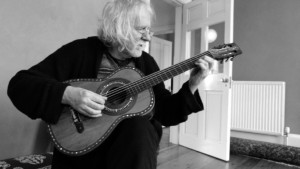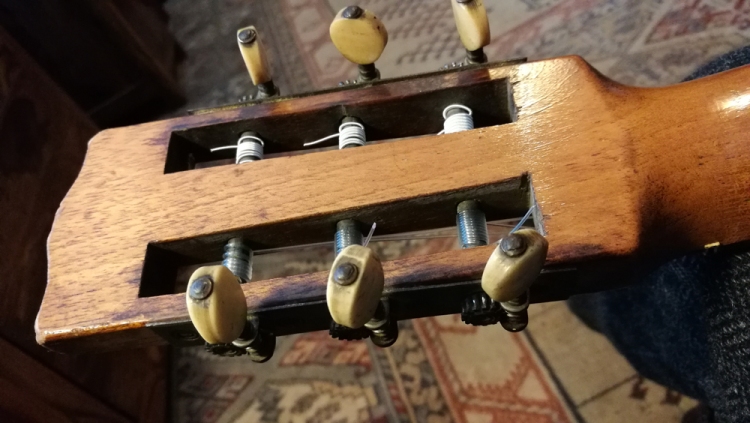UPDATE: I have started recording what will be a Download Album with this guitar. More info later.
[videos further down page]
One day early in 2019 I got a phone call from a man saying the local guitar store had given him my name, that he had an interesting guitar, and that he would like me to see it. “Okay, bring it round”. I didn’t expect much, as this had happened a few times in the past, and it was an education to me to realise that most people think antique = the 1960s. This time was different.
Iain Adam presented me with a guitar from 1870s Madrid, with a label carrying quite a bit of interesting information. The instrument was made by “Antonio Carlos Garcia, Fabrica de Guitarras y Mandolinas, Madrid”; that he had won gold medals is all expositions; and that the instrument was made for the Alban Voigt company of London. I quickly discovered that said Alban Voigt was an importer of all sorts of musical instruments, with offices at 14 Edmund Place, Aldersgate Street, London (near the Barbican).
The guitar model was called, “La Madrileña”, which I assume means a girl or woman from Madrid.
Iain said the guitar came down through his grandmother, who possibly played it, to his mother, who certainly didn’t, to himself, who used to “bash around on it” when he was a kid. There is evidence that the latter is true:
Apart from the faded bling, the first thing I noticed was that it had its original tornavoz intact:
The tornavoz is a brass cone attached to the edge of the sound hole, reaching deep within the instrument, almost touching the back. Its purpose seems to have been to lower the cavity resonance of the instrument, in other words giving a very warm bass, and consequently a mellow tone. The great luthier, Antonio de Torres of Almeria, used such things in most of his instruments, including the two he made for Francisco Tárrega.
I played a few few pieces by Tárrega on it, and was pleased to hear a beautifully romantic sound, clearly aged, yet still sounding quite strong. The neck is true – it is not bent or warped, so playing in tune is possible without surgery to the instrument. And the original tuners work perfectly. The bridge looks original, yet had clearly been moved. Iain informed me that local violin maker, Brian Rattray, had shifted the bridge to correct the intonation, some time in the 1970s. Well, it plays in tune very well.
It has some features of the Valencian school, and might possibly have been made there for a Madrid-based exporter. If so, did Antonio Carlos Garcia really make it, or did he even exist at all, with a Spanish name being used for the British market? More research is required.
At this point I was feeling two things: that I wanted the instrument, and that I probably couldn’t afford it. I asked Iain how much he wanted, and he said that he wanted it to go to someone who knew how to play it properly, and then offered it to me for a mere £400. Deal! And thanks.
I have since found that prices vary widely and wildly for these instruments, from around £400 up to over £2,000. No one seems to know what to charge for them. They are not top-level instruments, such as those by Torres, Manuel Ramirez, etc., but they have excellent timbers – a solid good-quality Brazilian rosewood back, for instance, and a good (German?) spruce sound board. The inlay is a little rough overall, and the bling is not to my taste, though thankfully time has been kind to it, fading the excess to a golden memory of a past age.
Videos
My intention is to put good-quality gut strings on, with silk-core wound basses, and make a number of videos. In the meantime, here is the first video, which only has gut strings for the B and G.








